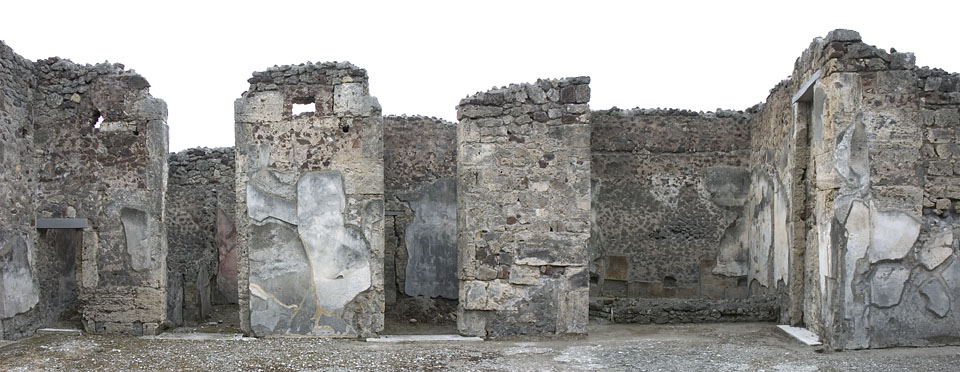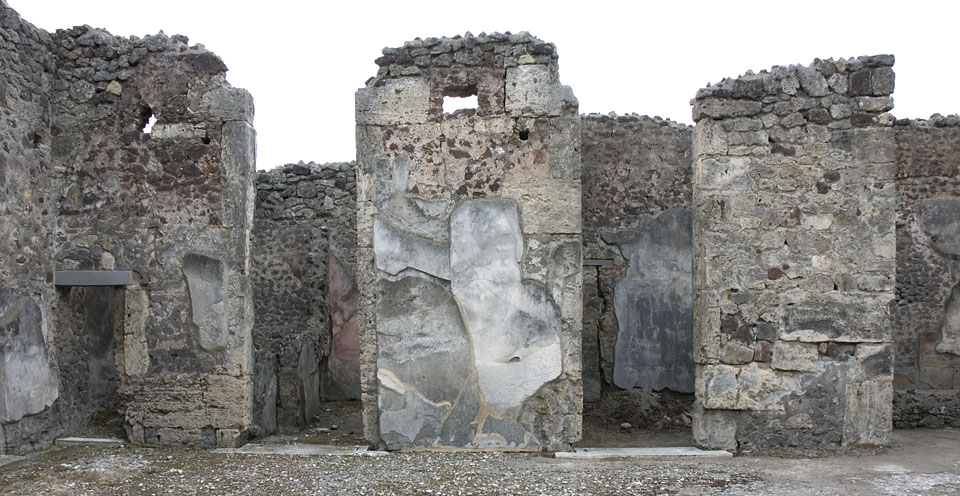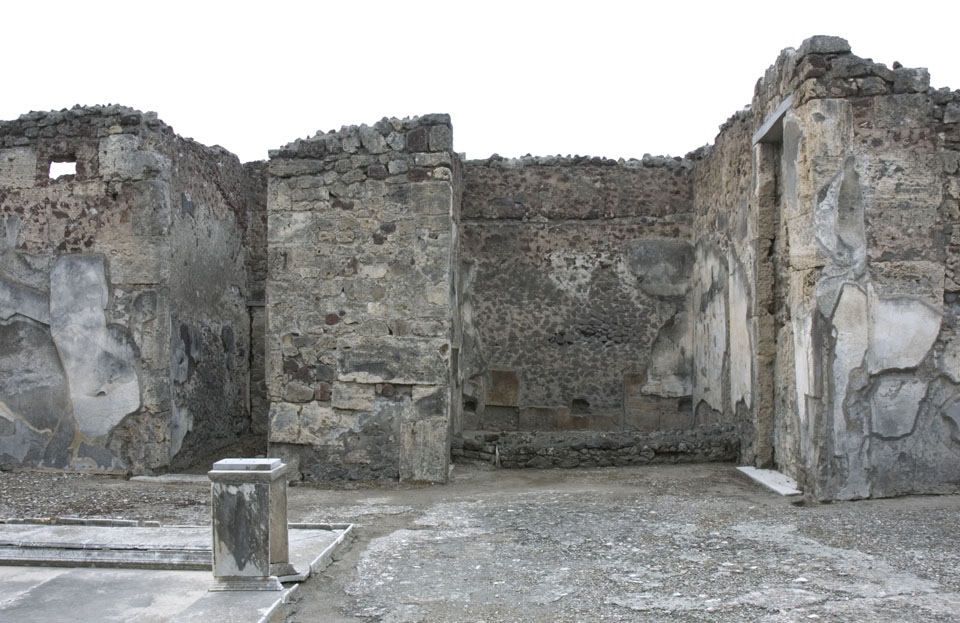West Wall
Description
Thomas Staub
West wall: width: 13.15 m.
Southern part (south western corner up to the southern doorframe to cubiculum16): width: 2.20 m, max. preserved height: 4.60 m, width of door towards room 17: 0.67 m, height: 1.82 m. The south wall of atrium4 forms the southern doorframe to room 17. The northern frame is built of standers and stretchers in Sarno stone: from bottom upwards: one block 0.25 x 0.35 m, with its lower corner towards the door cut off for 0.15 x 0.30 m, then one block reaching from the doorframe towards room 17 to the doorframe towards cubiculum16, 1.45 m wide, 0.55 m heigh, partly broken, then a stander, 0.35 x 1.30 m with a rectangular cutting off in the upper southern corner, where the modern lintel is inserted. On top of this, 3-4 stone layers in modern reconstruction (marked by a line in the modern concrete). Between the two doorframes, the wall consists, in the bottom, of one central Sarno stone block (0.50 x 0.25 m) framed to the south and north by lava-incertum. Above the already mentioned stretcher, the wall is made of opus incertum of lava inserted in reddish mortar, up to a height of ca. 2.00 m, above this, a stretcher from the southern doorframe to cubiculum16 reaches up to the upper northern corner of the lintel of the door towards room 17. In 1.05 m height, plaster covers a 0.50 x 1.10 m large area, showing a vertical line, 0.18 m to the south of the southern frame of the door towards cubiculum16, marking the position of the wooden frame. Above this, opus incertum of mainly red cruma, set into the reddish mortar. The south western corner is reconstructed, reaching from the corner above the lintel of the door towards room 17, to 1.10 m to the north in the upper rim of the wall. On floor level, remains of cut off bipedales are visible in front of the wall. The southern doorframe to cubiculum16 is, once more, constructed of standers and stretchers in Sarno stone, preserved up to a height of 4.00 m. The first block (0.25 x 0.20 m), once again shows diagonal off cuttings in the lower n corner (0.10 x 0.20 m). Then follows the above mentioned 0.55 m high stretcher between the door openings, then a 0.20 x 0.90 m large stander, then a 1.05 x 0.75 m large stretcher, then a stander, 0.20 x 1.20 m, and then, finally, a 0.70 x 0.50 m large block, whose upper corner has been cut off (0.20 x 0.10 m) for the insertion of a lintel (nor preserved, nor reconstructed). In 3.55 m height, 0.45 m to the south of the door towards cubiculum16, a Sarno block (0.60 x 0.20 m) is inserted into the cruma-incertum, at its lower northern corner; a rectangular hole (0.10 x 0.10 m) is visible in the wall. On the lower part of this section, metal dots can be observed on the wall. They are probably remains of the nails, with which originally the bipedales were attached to the wall (cf. description of west and north walls of ala14). Width of door towards cubiculum16: 1.23 m, height not measurable, min. 4.20 m.
Central part (between doors towards cubicula16 and 15): width: 2.40 m, max. preserved height: 4.40 m. This part of the wall is covered with plaster (no traces of paintings left) up to a max. height of 2.75 m. Towards the door to cubiculum16, the usual vertical line of the plaster for the insertion of the 0.18 m wide wooden doorframe is clearly visible, where as on the northern corner towards cubiculum15, the plaster has fallen down irregularly. Sarno stone blocks, whose widths because of the plaster are not determinable, once more form the doorframe to cubiculum16.The lowest one has a height of 0.64 m, with its lower southern corner cut off over the threshold (diagonally, 0.12 x 0.18 m). The following one has the same height, the next one 0.92 m. Then follows probably a stretcher, height: 0.52 m, then a stander, height: 0.85 m, width: 0.30 m, then a stretcher, 0.65 x 0.55 m, with its upper northern corner cut off for the laying of a lintel (nor preserved nor reconstructed). Also the doorframe towards cubiculum15 is constructed in Sarno stone blocks, again not all widths are measurable. The lowest one, with 0.15 x 0.15 m off-cuttings at the corner over the threshold, is 0.45 x 0.43 m large, the next one 0.35 m high, then follows a 0.55 m high block, then a stander, 0.35 x 1.02 m, then a stretcher, 0.90 x 0.60 m, then a stander, 0.35 x 0.60 m, followed by the uppermost stretcher, 0.80 x 0.55 m, on which the upper northern corner is cut away for the placing of the lost lintel. In 1.42, 2.30 and 3.25 m height, 0.20-0.25 m from the northern corner, a vertical row of round holes (diam. 0.04 m) is cut into the blocks, filled up with modern concrete. The wall between these two quoins consists of opus incertum, in the lower parts, where visible, mainly of lava, in the upper part (visible from 2.70 m height upwards) of red cruma, all set into the reddish mortar. The upper end of the wall consists of three layers of smaller Sarno stone blocks, probably a modern reconstruction. In 3.55 m height, a laying Sarno stone block is inserted into the incertum, at its lower northern corner a rectangular hole (0.08 x 0.08 m) is hewn into the stone. In 3.40 m height, in the middle of the wall, a window (0.40 x 0.30 m) opens up towards cubiculum16. Width of door towards cubiculum15: 1.30 m, height: min. 4.20 m.
Northern part (between doors to cubiculum15 and ala14): width: 2.18 m, max. preserved height: 4.40 m. No remains of plaster are left on this section of the wall. The door post towards cubiculum15 consists, as usual, of Sarno stone blocks starting with a 0.45 x 0.45 m large block, whose lower corner is cut off (diagonally 0.08 x 0.08 m) over the threshold. Then follows a stretcher, 1.15 x 0.50 m, and then a stander (0.20 x 0.85 m). Above this height, the doorpost is worked over with modern concrete and it seems as if this upper part is a modern reconstruction, still built with Sarno stone, but with smaller blocks. Even the doorpost towards ala14 consists in its lower part of Sarno stone standers and stretchers: first a block 0.58 x 0.75 m large, then one 0.40 x 0.40 m, and then a stretcher, 1.30 x 0.58 m. Here again, the remaining part is reconstructed in modern times with smaller blocks of mainly Sarno stone. The part in between the two doorposts consists up to a h of 0.90 m of opus incertum of lava into which, in about 0.28 m height, a Sarno block (0.60 x 0.20 m) is set. The mortar used is not determinable, since modern concrete covers all of it. The upper part is a modern reconstruction, using smaller blocks of mixed materials. Width of opening towards ala14: 3.80 m.



